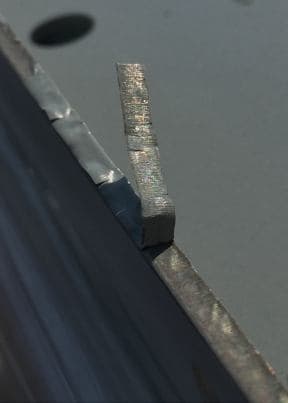
-----
Slag & carbon on laser cut edges
Q. We have started manufacturing parts using a laser; the parts have a carbon build on the edges, our present system is an alkaline, rinse, phosphate, rinse, seal. This system will not remove the carbon. Any ideas?
WAYNE DUGUAY- HOUSTON, Texas
1999
A. Wayne - What you are getting is known as "laser smut". This can easily be removed abrasively, or by using an acidic cleaner (sometimes called a de-smutter). Your chemical vendor should have noticed this and made an appropriate recommendation to reduce defective parts during a service visit. Be sure to rinse the parts well before putting them in the washer though -- it would play havoc with the alkaline cleaner. Good luck.
Dan Brewerchemical process supplier - Gurnee, Illinois
1999
A. My experience with laser cutting was on SS and it suffered from a similar problem. Edges had to be grit blasted. We worked with the vendor. He changed power settings and feed rate until we got an edge that we could live with. It would sulfamate nickel plate with adhesion.
James Watts- Navarre, Florida
1999
A. The easiest way to remove carbon deposits might be to heat the parts up in a furnace and burn the carbon off, if the parts can be heated. Then you would have to strip any oxides you form off the surface but it will definitely burn off the carbon.

John Davis
- Berthoud, Colorado, USA
1999
![]() I'm surprised that no one hit this one right on the head, but the correct answer is in the first response from Dan Brewer. When you cut parts with a laser you are generating a very high temperature at the edges of the piece. This causes an oxide to form. What's that? Same that happens when you heat treat steel in the presence of oxygen, heat scale (oxide). Heat scale is a form of iron oxide, which cannot be removed (very effectively) with alkaline cleaners. Just like the heat treater, you'll need to "pickle" the scale off your parts now or shot blast every part that is laser cut.
I'm surprised that no one hit this one right on the head, but the correct answer is in the first response from Dan Brewer. When you cut parts with a laser you are generating a very high temperature at the edges of the piece. This causes an oxide to form. What's that? Same that happens when you heat treat steel in the presence of oxygen, heat scale (oxide). Heat scale is a form of iron oxide, which cannot be removed (very effectively) with alkaline cleaners. Just like the heat treater, you'll need to "pickle" the scale off your parts now or shot blast every part that is laser cut.
This is very common and what surprises me the most about the laser cutting machinery industry is that they don't tell their customers much about how switching to laser cutting will change their lives as finishers. Sure they get a more precisely cut part, but unlike their die cut parts, they'll have to change their finishing process to get their paint to stick to the laser-cut edges.
Everyone that I can think of that has changed to laser cutting has had edge paint failures which forced them to look into this very same problem.
Good Luck.

Craig Burkart
- Naperville, Illinois
1999
Carbon Buildup on Laser Cut Edges
Q. I previously asked about cleaning of the carbon build on the edges of our laser cut steel parts. I was wondering if anyone has used nitrogen in place of the oxygen on the laser? Does this eliminate the carbon build? Will this reduce production any? If nitrogen is not the answer can we play with the power and speed and reduce the carbon build on mild steel parts? And YES I agree the sales rep's for the laser's should be up front about this problem! Help if you can. Thanks
Wayne B. Duguay- HOUSTON, Texas
1999
A. Laser Cutting mild steel is commonly done using O2 as an assist gas if you need oxide free smut free edges that will not create a problem for powder coat or other finishing processes you will need to use Nitrogen as your cutting assist gas this will shield the edge from oxidation. Traditionally this has been expensive but with PSA Nitrogen Generation it is now very cost effective and is the only sure solution to this problem.
Joseph Moretti- Rockaway, New Jersey
2007
Q. Can you recommend a pretreatment cleaning process for laser cut parts? The laser cut edge leaves an oxide area that causes adhesion problems. Often the cured powder coating will chip off these edges when they come into contact with each other. We have a four-stage washer using alkaline cleaning and phosphatizing. Most (98%) of our parts are HRP&O steel, with the remaining 2% being CR and aluminum. We also have heard that if we cut with nitrogen on the laser it will reduce the oxidation of the material; however, nitrogen is also 60% more expensive than oxygen.
regards
velu
- Kuwait
2007
Q. Hi
Could anybody please tell me the name of a company that sells electrolyte to deburr machined Stainless steel thin shims (preferably in USA). Actually, I am laser machining thin shim of SS for my research and getting the burr size about 5-15 microns. We have a deburring unit (Burlytic systems, model 60). The company is out of business now and we cannot get hold of anybody who can replace the fluid. Currently, the budget is not allowing us to buy a new one, so we would like to run the old one with new electrolyte. As these things are generally trade secrets, so nobody is really keen to tell the composition of deburring electrolyte. Any help relating my problem is greatly appreciated.
Thanks,
RESEARCHER - CORVALLIS, OREGON, USA
2007
----
Ed. note: We generally don't post brands or sources (why?), but if anyone wants to simply list a source or sources with no testimonials, slams, or comments, that would be okay.
A. Which grade of stainless are you using as the difference between ferritic and grade 304 is significant.
david gattward- Leicester United Kingdom
Multiple threads merged: please forgive chronology errors and repetition 🙂
Cleaning slag from laser cut spiral tube
February 17, 2012Q. I have a tube which has a spiral cut on the tube
Which allows the tube to bend/flex.this profile is created through
Laser cut. Thus there is some slag between the
Struts of the spiral cut and on the inside of
The tube. The space between the struts is
very small.
Any suggestions on how to clean the slag from between the struts
And on the inside? It has to be a high volume solution.
Ultrasonics in a pickle solution?
- Ireland
A. You are correct. We use ultrasonic with oxide removing solution on elevated temperatures. You have to select such pickling solution that is neutral to metal surface, and removes only slag oxide during ultrasonic cleaning.

Anna Berkovich
Russamer Lab
Pittsburgh, Pennsylvania

February 21, 2012
Multiple threads merged: please forgive chronology errors and repetition 🙂
Q. Regarding 12 ga. Carbon Steel panels that have been laser cut in patterns ... What is the best metal prep/cleaning prior to powder coating?
Thom Foulks- Stockton, California, USA
July 8, 2013
A. Thom,
One way is to file the edges and make sure they nice and smooth and all the panels fit together. You may need to deburr a bit. Next, you can use a rotary tool to polish around the weld seam areas. I would start light, maybe even use Scotch-Brite only (not the heavy duty type to start). You mention laser cutting so you might also want to use a wire brush. Remember, go light to start, not too heavy. Let me know, I can grab some tools, stop by and give you a hand.

Blake Kneedler
Feather Hollow Eng. - Stockton, California
July 12, 2013
Q. Has anyone had good results using an Acidic cleaner (De Smutter) in their wash system to remove laser carbon? We produce thousands of pieces from our laser, and manually grinding isn't a good option. Is there not a good chemical to possibly hand wipe the parts, if the Acidic Cleaner doesn't cure the problem?
Wally Melton- Chuckey, Tennessee
July 15, 2014
Powder coat poor adhesion - What is this?
August 6, 2015Q. Good day. We make many products for the electrical industry including sheet metal enclosures.
We are having issues with powder coat peeling from the edges of laser cut parts. The parts are cut on a new hydrogen laser and the edges come off very clean - no slag. These are 11 gage 1010 steel.

Our Powder coater sent this picture of with what appears to be some sort of contaminant but we are a loss as to what it might be.
Any input would be appreciated.
Thank You
James
Quality - Cincinnati, Ohio, USA
A. James,
I would say that from the image you have provided, the contaminant appears to be carburisation of the parent metal. I'm not familiar with the operation of lasers, least of all hydrogen ones, but I assume that there is another type of gain medium present other than just Hydrogen, for example Carbon Dioxide?
If so, it's possible that the carbon dioxide is being absorbed into the parent metal during the cutting process (due to the heat).
This being the case, there are a number of actions you can take to remedy it, most of which are detailed in the replies above -- such as altering the current/feed rate in order to minimise the effect, or blasting (may be difficult with such a thin product).
I hope this helps,
Michael
Heat Treatment Manager - Glasgow, Scotland, UK
August 6, 2015
Multiple threads merged: please forgive chronology errors and repetition 🙂
Laser cutting slag removal from 304 tube - pickling solution options?
Q. We have several hundred .625 in x 3 in 304 stainless steel tubes that were laser cut to add various tabs and slots. During the process a relatively large amount of slag was deposited onto the ID of the tubing.
In order for the parts to be functional, the ID needs to have a decent surface finish, or at the very least not be rough from slag. Previously we have been reaming them out one at a time, but it's not a financially viable option. We also need to avoid any chance of hydrogen embrittlement.
We have several powerful ultrasonic cleaners which can heat up to 170 °F that we normally use to run a citric acid passivation line.
I've done quite a bit of research and am having trouble tracking down a commercial inhibited pickling acid or proprietary blend that we can buy in small quantities (1-5 gallons). If someone can give the method for making our own inhibited acid for stainless, that would be great as well.
Any suggestions would be greatly appreciated (both for supplier and method).
Manufacturing Technician - Austin, Texas, United States
August 25, 2015
----
Ed. note: This site is "no registration required" and we can't publicly post recommendations or slams of proprietary processes or suppliers (why?), but we do welcome comments on general processing information.
A. Brian, in order to suggest some etching solutions and regimes, we would need to test some samples, to see if the strength of the etching solution is enough for the level of burrs inside tubes.
adv.
Our methods of etching do not cause hydrogen saturation. Contact me directly.

Anna Berkovich
Russamer Lab
Pittsburgh, Pennsylvania

August 26, 2015
Q, A, or Comment on THIS thread -or- Start a NEW Thread